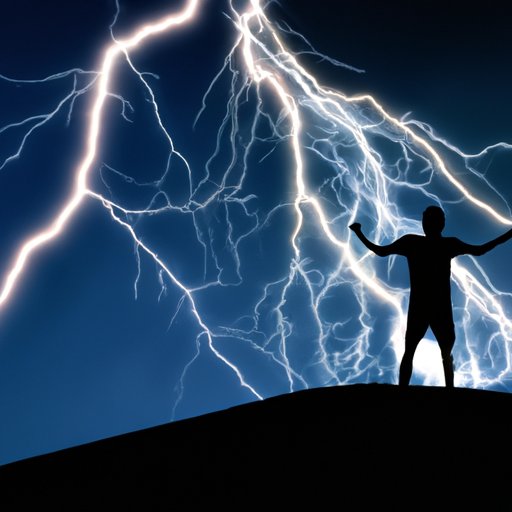
Introduction
Lightning can be a beautiful and awe-inspiring sight, but it can also be incredibly dangerous. Every year, people around the world are struck by lightning, with potentially life-changing consequences. In this article, we’ll explore what happens if you get struck by lightning, including the dangers and risks, the recovery process, and the strategies you can use to avoid lightning strikes and protect yourself from harm.
When Lightning Strikes: Understanding the Dangers and Risks
Lightning strikes occur when an electrical charge builds up in the atmosphere, causing lightning bolts to form and strike the ground or other objects. According to the National Weather Service, lightning strikes cause an average of 20 fatalities and around 280 injuries in the United States each year.
Factors that can increase the risk of being struck by lightning include being outside during a thunderstorm, standing near tall objects, such as trees or metal poles, or being in an open area with no shelter.
The potential dangers and risks associated with lightning strikes can be severe and varied. The lightning current can cause burns and tissue damage, in addition to neurological damage and other injuries, such as hearing loss, vision loss, muscle weakness, memory problems, and more.
From Shock to Recovery: Surviving a Lightning Strike
When a person is struck by lightning, the electrical charge can cause a range of effects on the body. The electric current can travel through the ground and enter the body through the feet, then travel up the legs and through the body, potentially damaging internal organs and causing cardiac arrest.
Other physical injuries that can result from lightning strikes include burns, both external and internal, fractures, and muscle damage. Additionally, the electrical shock can cause neurological damage to the brain and nervous system, resulting in a range of long-term effects on cognitive and motor function.
The recovery process for someone who has been struck by lightning can be lengthy and often involves hospitalization and rehabilitation. Physical therapy and counseling may also be necessary to help the survivor cope with the long-term effects of the injury.
Electrifying Facts About Lightning Strikes and Their Consequences
Lightning strikes can have a range of effects on the environment, beyond the damage caused to buildings and other structures. Each lightning bolt can heat the air around it to temperatures of up to 30,000 degrees Celsius, causing thunder and even creating small-scale explosions in some cases.
Lightning strikes can also impact the soil and plants around it, causing changes in the pH levels of the soil and leading to increased growth rates for plants. Forest fires can also be sparked by lightning strikes, causing additional damage to the environment.
What to Do and Not to Do If You’re Ever Struck by Lightning
If you find yourself outside during a thunderstorm and lightning is present, it’s crucial to take steps to protect yourself and reduce your risk of being struck. Avoid standing near tall objects or being in an open area, and seek shelter inside a sturdy building or vehicle if possible.
If shelter isn’t available, crouch down low to the ground, keeping as low as possible without lying down, to reduce your height and minimize the risk of being struck. Avoid touching metal objects or electrical equipment and don’t take shelter under trees or other tall objects that could attract lightning.
It’s important to note that common myths and misconceptions about lightning safety, such as lying flat on the ground or seeking shelter under an overpass during a thunderstorm, can actually be very dangerous and increase your risk of being struck by lightning.
Surviving a Near-Death Experience: A Lightning Strike Survivor’s Story
Lightning strike survivors often have unique stories to tell about their experiences, including the physical and neurological effects they experienced and the lessons they learned about lightning safety.
One such survivor, John Jensenius, a meteorologist with the National Weather Service, was struck by lightning while sitting inside his home in 2010. He suffered a range of physical injuries, including burns and nerve damage, as well as neurological effects that impacted his memory and cognitive function. He now works to raise awareness about lightning safety and the potential risks associated with lightning strikes.
The Science Behind Lightning Strikes and Their Effects on the Human Body
The electrical charge from a lightning strike can cause a range of effects on the human body, both physical and neurological. The electrical current can disrupt the normal functioning of the body’s nervous system, potentially causing long-term cognitive and motor function problems.
Research into the long-term effects of lightning strikes is ongoing, with studies suggesting that survivors may be at increased risk of developing Parkinson’s disease, depression, and other neurological conditions later in life.
Preventing Disaster: How to Avoid Lightning Strikes and Protect Yourself from Harm
Staying informed about the weather forecast and being aware of the risks associated with lightning strikes can be an important part of preventing disaster. Strategies for protecting yourself from lightning strikes include staying indoors during thunderstorms and learning to recognize the warning signs of an approaching storm.
For outdoor activities, it’s essential to have a plan in place for seeking shelter if lightning is present, including identifying potential shelter locations in advance and being prepared to move quickly if needed. Personal lightning detectors and smartphone apps can also provide real-time information on lightning strikes in your area, helping you to stay informed and reduce your risk of being caught in a potentially dangerous situation.
Conclusion
Understanding the dangers and risks associated with lightning strikes is an important part of staying safe during thunderstorms. By following safety guidelines, staying informed about the risks, and remaining vigilant during stormy weather, you can help reduce your risk of being struck by lightning and keep yourself and those around you safe.





